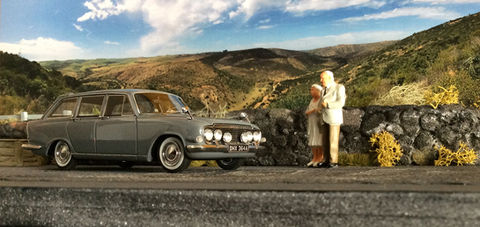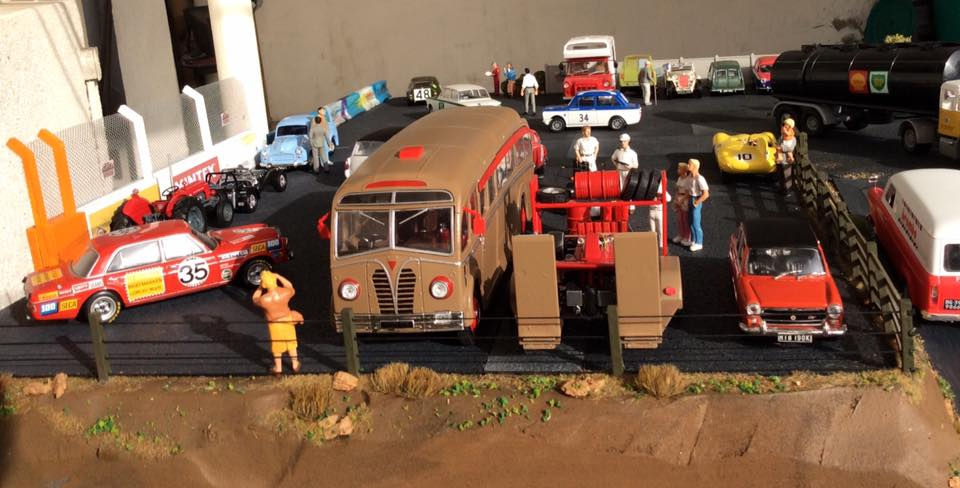
Collector. Scale Modelling Artist. Diorama Creator. Miniaturist
Hello and welcome to my website!
I am Fraser, an avid collector of British 1:43 scale models, based in Dubai.
I specialise in the period I am familiar with from my youth and combine
my models with a bit of imagination, to recreate motoring and motorsport scenarios that are, were or could be familiar.
My formal training as a graphic designer has helped me maintain what I think is a good eye for detail and scale, and I delight in repurposing things that would otherwise be scrapped.
I am proud to be able to present a selection of my work to a wider audience than my current Facebook sufferers!
Though it is mostly for my own entertainment, I am keen to broaden my skills, so any advice, comment, recommendation or trick you are willing to share, will be most welcome.
SIMPLY CLICK ON MOST PHOTOGRAPHS TO ENLARGE
Please get in touch and thanks for looking in.
MOTORINGMODELS.COM

200 L5-/CR 4+ -> !!!R4 - SLIPPY/BGJMP OC
MY LATEST PROJECTS... I'VE BEEN ON ESCORT DUTY

MK1 FORD ESCORT - A BRIDGE TOO FAR?
Another halcyon motorsport moment, when rallying was in its prime or perhaps a scene from a more recent classic rally revival event in the Isle of Man...either way this Escort is at 'full chat' and airborne!

SOMEWHERE IN SCOTLAND?
Probably in May....given the dusting of snow on this highland special stage, perhaps Clashindarroch, Bennachie or Durris?

I'VE JOINED THE PADDOCK CLUB...
Ah the good old days of motorsport - How many car manufactuers and models can you name?
THE MOTOR TRADE OF DAYS GONE BY
Who remembers the 'Motor Factor'?
MOTOR FACTOR: (England, Scotland, and Ireland) A term originating in the late 1920's to describe a supplier of car parts and accessories. However, according to 'Motor Trader' magazine; to qualify as a "Motor Factor"..."Factoring" must be the main business of the company. They must be a first line supplier, not a wholesaler or importer which supplies factors. They will be delivering parts on a just-in-time basis to garages, fast fits and fleet workshops. Deliveries will occur at least twice a day, almost certainly in the company’s own vans. Finally there will probably – but not necessarily – be some retailing activity as well".

THE HUB OF THE LOCAL MOTOR PARTS TRADE
This busy scene from the 60's / 70's has been faithfully recreated here to show what a busy meeting place the local Motor Factor was for everybody involved in the motor trade back in the day.
MY DIORAMA
Modellers are renowned as being ingenious and resourceful when it comes to sourcing (scavenging?) and recycling items for scenery, but any guesses as to the origins of this building structure?

RECENT PROJECTS
I have just completed a Code3 conversion of a Whitebox Limited Edition
Land Rover Series 2 model to represent the actual car of a friend here in UAE.
It got a proper paint job and all sorts of other fiddly detail work using balsa, plastic sprue, stuff from the parts bin, wet-wipes, thread and acrylics!
Learned a lot on that one, but not a bad result!
PRE-BUILD PLANNING
A few random models, some bought and some home-made components, (including the chain-link fence, reeds and grass patches, exposed plaster of Paris rocks, trees, shrubs and a bit of hedgerow) on top of the original sketches and half-scale working drawings for what turned out to be the Prestige Motors and Prestige Workshop diorama.

BEHIND THE SCENES
Reality Check - No.... I don't have a fully equipped spray booth behind my house!




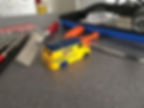
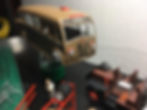
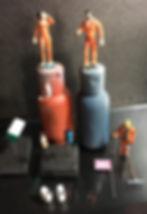
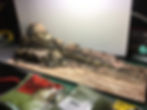


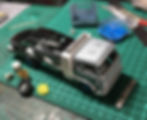
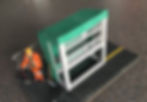
FEATURED BUILDS
Special Vehicle Operations - An interesting Code3 period conversion, from an otherwise unwanted toy.

I’m not keen on modern graphics on a period body, so the Corgi Club and Oxford Christmas Specials have generally been found new clothes. I really hated the lurid blue and yellow combination here – it just did not look like a real van.
As can be seen from the worktop, various saws, files and the trusty Dremel were brought into action, and with the shell stripped and marked, the conversion to a rusty pickup was started.
Once cut and filed, I primed the metal that was left in red oxide, coated it roughly in salt whilst it was still wet enough to stick, and then resprayed a top coat of satin yellow over the salt. When baked in the sun (I wasn’t too bothered about dust!) the salt was washed off and the model reassembled and detailed.


A coarse bulkhead was made from corrugated plastic and painted, along with the model floor, to look a bit like wooden decking – the rear was to be filled with junk tyres and rubbish anyway.

A TRANSPORTER - BACK TO ANOTHER TIME
Coach to Period Race Car Hauler Conversion

START OF A COACH TRIP
I bought the AEC Harrington Coach from Carmodel in Italy – it was on sale, and at 15 Euros, difficult to refuse despite not having a plan for it, other than a diorama prop of some sort. Likewise, a GMP trailer at 19 Euro seemed a good investment for some diorama padding.

THE PARTS - TAKEN APART
The finished picture, Round 1, had temporary cars from my collection – both the Alan Mann Cortina Lotus and the Escort, just to add to the picture of the finished transporter. The final display is more of the Gentleman‘s Equipe originally envisaged – an Edicola (cheap!) ex-Fittipaldi Lotus 72 (I prised Emerson out!) and a red, Oxford Diecast, AC Aceca with some numbers on it, to represent an historic racer.

X MARKS THE SPOT
The body area to be removed for the open rear ennd was marked, carefully cut and meticulously removed.

IT TAKES TWO TO TOW
It was not until I watched some of the Goodwood Revival that I got the idea for a period race car transporter, and with the GMP trailer sitting in a box in the wrong colours, I hatched a plan to build a Gentleman’s Equipe, as it might have been used in the late 1960s or 70s.

THE TRAILER
The trailer came apart quite easily, but the AEC Regal Coach was made of sterner stuff and had far more components to it than its price would have suggested. These were separated from one another to reveal a plastic chassis that was stiffened by the seat structure glued in place as a separate component. By this time, I had decided that only the first two rows of seats, after the driver, would remain, and the bulkead shifted to make a ‘weatherproof’ division between the crew seats and the transport compartment.

PAINT + ASSEMBLY
Rattle cans did most of the basework, the brown being an innocuous enough colour not to present too many problems. The red and silver trims were finished by hand, as was the grille detail. The trailer got the same treatment with the addition of a load of tyres, fire extinguisher and jerry cans. The bus got some toot as well.

PROJECT SHELVED UNTIL A PADDOCK CAN BE FOUND
There are some extra bits, a few team people and the ramps to complete the setting – I just need to get round to building a paddock diorama to place them in!

New to Old Code3 Conversion
SHERPA VAN
My skanky builder’s van started life as yet another Edicola James Bond model – the telephones van from “The Spy Who Loved Me”. I like the Edicola models for conversion – the castings are usually good and they are inexpensive enough to tear apart and rebuild.
Some of the detailing on the original model is a bit heavy-handed for scale – the chromed roof rack, for example, and a number of chromed parts that would never have been chromed on even the “deluxe” version of anything British Leyland Commercials were producing in the mid-1970s.
Having stripped out the various components, the shell was then given a bath in paint remover, and an undercoat of red oxide primer. The painted shell was salted and top coated in a matt pale blue from a rattle-can, then washed. Selected panels were then brushed over in a darker blue to give the second-hand parts look, and the whole thing sealed in satin varnish, after a bit of further weathering.
The interior plastics were repainted to give a patina of wear and to alleviate the solid shiny black, the dashtop was also painted and a few bits of ‘paperwork’ junk added for realism. The roofrack was remade with paperclip corners and cotton-bud stems to give it position on the original mounts and loaded up with the sort of material likely to be found in such a place – a tarpaulin, some boards, bits of scaffold and pipe – and secured with cobbler’s thread as tie-down straps.
Mismatched wheels, hubcaps, bumpers and so on were variously remounted and dulled down or painted in other colours to maintain the ‘tired and abused’ look. The heater grill and wipers were blacked in and the mirrors dechromed before fitting.
Turning a cheaper model into something more interesting just takes a little time and imagination. The great thing about Code3 models, especially when making something worn-out looking, is that you don’t have to worry too much about mistakes in the finish – as you can see!

PROJECT P38
The P38 Range Rover was not one of Land Rover’s finest, as a manufacturer. Many P38s ended up in fields, rotting on collapsed suspension or having been damaged beyond economic repair.
The full-sized car was the 2nd Generation Range Rover, the first new car to bear the name in 24 years. Though not launched until 1994, six years beyond my collection period, I felt it needed to be part of a scenario appropriate to its final demise.
At under nine Euros in a sale, who could resist Edicola’s James Bond, “Tomorrow Never Dies” film version? Like many of the Edicola offerings, it was a fairly accurate casting marred only by heavy chrome detailing, so it was stripped to component form, the interior removed and the parts saved for later use.
I put the floorpan and body back together, complete with wheels and axles, and placed the shell in a plastic bag. I then took it out to my garage and drove my car over it! The resulting misshapen remains looked just like a number of P38s I have seen. Some of the interior, some chrome (a headlight, tail-lights, part of the grille, a mirror…) were added and the now-twisted axles were repositioned to represent the typically collapsed air suspension of the actual cars.
The finish was done with several coats of hairspray, interspersed with a liberal coating of dust, achieved by sweeping my yard over the sticky bodywork.
It now sits proudly, amongst other victims, in a Breaker’s Yard diorama as a somewhat sad and neglected parts donor vehicle.
FLOATING AN IDEA
Restoring and Repurposing a Fleet of Electric Milk Floats
A fleet of four, tired and unloved early 1950s Dinky Milk Floats was sourced for me from various car boot sales and other sources back in Scotland.
The first of the repurposed electric Milk Floats, thought to be circa 1949-1954 and now reshaped and resplendent in new colours and custom decals. Craftily converted into a Landscape Gardener's runabout.... ideal for the BBC's Beechwood Garden or the small estate! Kitted out with some shrubs (roots bagged) , a few slabs and bricks, bits of pipe and fencing, a jerry can for the lawnmower, a shovel and a few logs, a bucket and some bags of soil and gravel.
Of the remaining three, one will stay as it is for reference and good governance; the other two will get Code3 refurbishments.

"Thrive for precision and perfection will follow"
“Details make perfection, and perfection is not a detail.”
– Raghav Sharma - Leonardo Da Vinci,

BIO
I am a native Scot, but have been based in Dubai for most of my working life.
I am a Senior Motor Sports Official and also provide professional driving solutions for a diverse range of motoring and motorsport events and activities, for vehicle manufacturers and other clients across the Middle East and North Africa regions. I have also written hundreds of articles on vehicles and have been published extensively.
Building scale models and dioramas in what spare time I have, is relaxing and therapeutic, and allows me to translate a bit of my knowledge and experience with full-sized vehicles into fun, miniature art.

USEFUL CONTACTS
It is always good to know who else can help out there
I have been collecting British vehicles from between 1948 and 1988 for quite a while now, and there are some model makers who are consistently good and some who are a bit patchy in their manufacture. Surprisingly, some of the cheaper models were excellent in both finish and build and some of the more expensive ones were, well, a bit crap! You’ll just need to see what suits you best.
There is no sponsorship on this site, but I have found, in the two short years I have been model making, several companies who have been particularly professional or worthy of mention.
These are all worth a visit:
www.Carmodel.com Italy-based model car stockist, all scales. Good service, excellent packaging, fair policies and the odd discount. I source mainly with them.
www.britishheritagemodels.co.uk Small batch and interesting model suppliers: no inexpensive models, but some nice stuff.
www.greenstuffworld.com Spanish supplier of diorama toot: static grass, paints, plastic, 3D-printed street furniture, LED kit. All sorts of stuff you did not know you needed.
www.peco.uk UK based model railway suppliers, but has good ranges of ‘O’ Scale stuff, which looks right. Kits and ready-made fencing, phone boxes, etc.
www.modeltechstudios.com as above
www.modelshop.co.uk as above
www.blacksquaredecals.co.uk Brilliant personal service for old repro decals or custom-made decals. Really helpful.
www.recovertoy.com Australian remanufacturer of old Dinky and Corgi parts; screens, wheels, tyres, drivers and so on.
I have some Australian models of British cars sold on that market (when there was a British car industry!): they were sourced directly from www.urtradinginternational.com who are based in Oz, and are the producers of TraX models. Other odd stuff is from a periodic trawl of eBay and ‘distant friends’ on scavenger hunts in Scotland.
CONTACT ME
Thank you for taking the time to visit my motoringmodels.com website and reviewing my modelling portfolio. Please get in touch with your comments or questions.






